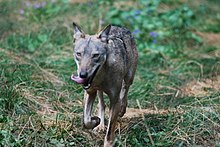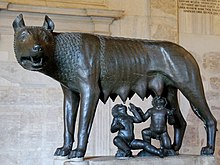Italian wolf
The Italian wolf , also known as the Apennine wolf , is a population of the wolf that inhabits the Italian peninsula and parts of the French Alps . These wolves differ morphologically and genetically from other European wolves, whereupon they were partially classified as a separate subspecies Canis lupus italicus . The differences are apparently not due to increased cross-breeding of domestic dogs into the Italian herd. The Italian wolves are currently assigned to the Eurasian wolf ( Canis lupus lupus ).
features
The fur of the Italian wolf is gray-brown on the flanks, white on the inside of the legs and on the belly, and black on the back and on the forelegs. The pronounced black color on the front of the forelegs is an important feature of the Italian wolf, which is not or only partially found in other wolf populations or subspecies.
Italian wolves are a rather small wolf shape and usually reach a shoulder height of 70 cm and a head-torso length of 150 cm. The weights are subject to certain fluctuations depending on the region, but are on average around 30 kg for females (females) and 35 kg for males (males). In the French Alps, average weights of 28 kg for females and 36 kg for males were determined.
nutrition
Compared to some other populations of the wolf, the Italian wolf prefers smaller ungulates as prey. In Italy these are v. a. Roe deer , red deer and wild boar , in the Alps also chamois , among the domestic animals sheep and goats . Cows and horses are very rarely killed. It is practically always calves and foals, adult animals are rarely killed. One reason may be the rather small body size of the Italian wolves. In addition, neither elk nor bison were found in their original habitat , which is why wolves probably did not specialize in large animals (unlike in North America, for example).
distribution
All of Italy, including Sicily, is considered the historical habitat of the Italian wolf. The Italian wolf currently inhabits large parts of the Apennines from Calabria to Liguria and the western Alps. In the Alps, the French Alps and Piedmont in Italy are populated by packs. The Swiss Alps have been populated by solitary animals for several years. In 2012, the first herd in Switzerland after the last extinction formed on Calanda near Chur . There is disagreement about the exact number of wolves, it should be between 500 and 1000. The population continues to expand, particularly in the Alps.
Hazard and protection
Historical development
The Italian wolf, like the other populations of the wolf, was heavily hunted by humans , although it played an important role in Italian history and enjoyed a relatively high level of sympathy compared to other countries (see Romulus and Remus ). The Italian wolf initially disappeared from the Alps towards the end of the 19th century. The last wolf kill was confirmed in Sicily in 1924, but there are reports of kills from the late 1930s and alleged sightings from the 1960s. The wolf was still widespread in the hills and mountains of the Apennines towards the end of the 19th century. It was probably only after the Second World War that its spread through hunting with firearms and especially poisonous bait was massively suppressed. At the beginning of the 1970s the population reached a low point of around 100 animals (1973 wolf census), and the Italian wolf was on the verge of extinction. Its occurrence only extended to ten isolated areas in central and southern Italy with a total of 8500 km², of which the largest area was in Abruzzo . Population genetic calculations carried out in the 1980s showed that the low around 1970 was only 40 to 50% of the minimum population required for short-term population maintenance. Had the population continued at this level, the rapid development of inbreeding depression would have threatened.
The Italian government responded in 1976 by protecting the wolf and banning the use of poison bait. After it was placed under protection, the wolf population continuously recovered and spread again throughout the Apennines. In 1983 the population had risen to 220 animals in an area of 13,500 km² and wolves reproduced as far as the north of Genoa . The minimum population required for short-term population maintenance was thus achieved again. The population size required for the long-term preservation of the Italian wolf was put at 2000 animals in the mid-1980s, assuming constant population-biological boundary conditions (population density that can hardly be increased, ongoing illegal hunting). This target size would have corresponded to an expansion of the distribution area to 130,000 km², about 43% of the area of Italy. In addition to doubts about the feasibility of this objective, questions about the purity of the remaining wolves and about the danger of an increasing accumulation of dog genes in the re-expanding wolf population became the focus of scientific interest. There was fear of increasing matings with free-range or feral domestic dogs , the number of which in 1983 was estimated at 850,000 free-range and 80,000 feral dogs.
In 1987 a wolf was recorded for the first time in the Italian Alps, and in 1992 in the French Alps. In 1995 wolves immigrated to the canton of Valais in Switzerland. Around 2000 the Italian population comprised around 400 animals. In 2006, an Italian wolf was first detected in Germany.
As already mentioned, mixing with domestic dogs was and is viewed as a threat to the population of "pure" wolves. Since the population of feral or stray domestic dogs in Italy far exceeds that of wolves, some seriously consider interbreeding. It is known that in the past there have been matings between wild wolves and domestic dogs in Italy, but it has been proven that the Italian wolves have so far remained pure breeding.
Current status
In its Red List of Endangered Species (IUCN 2018), the World Conservation Union (IUCN) identifies two sub-populations for the wolf in Europe that affect the Italian wolf: a sub-population on the Italian Peninsula and a sub-population in the western and central Alps.
The subpopulation on the Italian Peninsula is estimated at 1,100 to 2,400 animals with a slightly increasing tendency. Assuming that the number of individuals is in the middle range, it is classified as Near Threatened (potentially at risk). There is a limited genetic exchange with the neighboring subpopulation in the western and central Alps, but presumably only towards this neighboring population. There is a local hazard potential through local extinction of wolves as a result of human hunting (using poison bait or shooting) and through locally frequent breeding of wolves with domestic dogs. Assuming the estimated lower number of individuals of 1100 animals, the subpopulation would fall below the number of 1000 adult animals required for long-term maintenance and would be classified as vulnerable .
The alpine subpopulation in the western and central Alps is estimated at 550 to 700 animals, including 330 to 415 adult animals. It has increased by 10 to 20% annually in recent years. In view of the limited genetic exchange with its original population on the Italian Peninsula, the Alpine subpopulation is regarded as a separate subpopulation. Due to its small size and wide geographical distribution, it is classified as a vulnerable (endangered) with comparatively strong isolation .
literature
- Erik Zimen: The Wolf - Behavior, Ecology and Myth. Franckh-Kosmos Verlags-GmbH & Co., 2003, ISBN 3-440-09742-0 .
Web links
Individual evidence
- ↑ V. Lucchini, A. Galov, E. Randi: Evidence of genetic distinction and long-term population decline in wolves (Canis lupus) in the Italian Apennines . In: Molecular Ecology . tape 13 , no. 3 , March 2004, p. 523-536 , doi : 10.1046 / j.1365-294X.2004.02077.x .
- ^ A b Ronald M. Nowak, Nicholas Brusco E. Federoff: The systematic status of the Italian wolf Canis lupus . In: Acta Theriologica . tape 47 , no. 3 , 2002, p. 333-338 , doi : 10.1007 / BF03194151 .
- ^ Claudio Sillero-Zubiri: Family Canidae (Dogs). In: Don E. Wilson , Russell A. Mittermeier (eds.): Handbook of the Mammals of the World. Volume 1: Carnivores. Lynx Edicions, Barcelona 2009, ISBN 978-84-96553-49-1 , pp. 352-446, here p. 413.
- ↑ Report on the occurrence of black stripes on the foreleg of the wolf on page 19 ( Memento of the original from November 19, 2008 in the Internet Archive ) Info: The archive link was automatically inserted and not yet checked. Please check the original and archive link according to the instructions and then remove this notice.
- ↑ Weights determined in France
- ↑ Balance of the damage in France 2005 and 2006 on page 6 ( Memento of the original of November 19, 2008 in the Internet Archive ) Info: The archive link was inserted automatically and not yet checked. Please check the original and archive link according to the instructions and then remove this notice.
- ↑ a b c d Luigi Boitani: Genetic considerations on wolf conservation in Italy . In: Italian Journal of Zoology . tape 51 , 1984, pp. 367-373 , doi : 10.1080 / 11250008409439476 .
- ↑ Francesco Maria Angelici, Lorenzo Rossi: A new subspecies of gray wolf (Carnivora, Canidae), recently extinct, from Sicily, Italy . In: Bollettino del Museo Civico di Storia Naturale di Verona (= Botanica Zoologia ). tape 42 , 2018, ISSN 2499-5681 , p. 3–15 ( full text [PDF; 5.9 MB ]).
- ↑ a b Ettore Randi, Vittorio Lucchini, Mads Fjeldsø Christensen, Nadia Mucci, Stephan M. Funk, Gaudenz Dolf, Volker Loeschcke: Mitochondrial DNA Variability in Italian and East European Wolves: Detecting the Consequences of Small Population Size and Hybridization . In: Conservation Biology . tape 14 , no. 2 , April 2000, p. 464-473 , doi : 10.1046 / j.1523-1739.2000.98280.x .
- ↑ Chronology of the expansion ( memento of the original from September 14, 2007 in the Internet Archive ) Info: The archive link was automatically inserted and not yet checked. Please check the original and archive link according to the instructions and then remove this notice.
- ↑ a b Wolves find haven in Italy. BBC News, April 25, 2000, accessed February 20, 2019 .
- ↑ First records of category C1 of wolves in Bavaria 2006 to 2018. (PDF; 103.6 kByte) Bavarian State Office for the Environment, accessed on February 21, 2019 .
- ^ Claws reveal survival wolf threat. BBC News, April 8, 2000, accessed February 20, 2019 .
- ↑ L. Boitani: Canis lupus. The IUCN Red List of Threatened Species 2018: e.T3746A133234888 . 2018, doi : 10.2305 / IUCN.UK.2018-2.RLTS.T3746A133234888.en .



